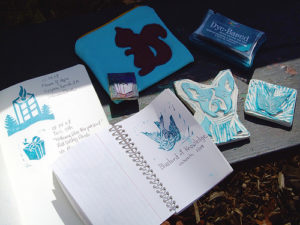
 Who doesn’t like a treasure hunt? And with kids involved, the delight of adventure is intensified. Maybe you have heard of a certain world-wide activity that blends creativity, clues and observation, and exploring the outdoors, all in one. It is called letterboxing. It’s a lower-tech version of geo caching, if you will.
Who doesn’t like a treasure hunt? And with kids involved, the delight of adventure is intensified. Maybe you have heard of a certain world-wide activity that blends creativity, clues and observation, and exploring the outdoors, all in one. It is called letterboxing. It’s a lower-tech version of geo caching, if you will.
According to one letterboxing website, the tradition began in 1854 when a man put his calling card in a bottle, leaving it in a remote pool or pond in England. Adventurers who made it to this nearly inaccessible site left their own calling cards in the bottle, and eventually in a tin box. Visitors began to leave self-addressed post cards so the next person to find the post card would mail it back from his or her hometown. People would receive their self-addressed post cards in their “letterboxes,” as mailboxes are known in England – thus developed the name and the tradition. Over time the practice evolved to include a log book, a rubber stamp, and a more element-resistant box, to become what it is today.
Now about letterboxing today. First: creativity. To get started, utilize your original thinking by coming up with a trail name for yourself. Once you decide on that, buy a rubber stamp that represents who you are, or create your own stamp from materials as simple as a wide eraser and an exacto knife. I have even seen stamps from linocuts and woodcuts by letterboxers who are skilled in those artistic media. Buy an inkpad, a small notebook, such as a little spiral Mead that fits in a jacket pocket, and a compass. Then put it all in a sturdy Ziploc bag and, viola, you are almost ready to letterbox. (The idea is not to spend a fortune and not to weigh yourself down so there is no need to invest in anything fancy.)
Next step: find a box to search for. Visit www.letterboxing.org or www.atlasquest.com to register your trail name and find clues to a box in your desired area. People plant boxes and post the clues online. Print the clues and walk/bike/drive yourself to the starting point. Once there, use your keen sense of observation to seek landmarks and make your way to a carefully hidden and camouflaged Tupperware or similar waterproof container, a.k.a. the letterbox.
Moving away from the precise hiding spot so other potential letterboxers coming down the trail don’t see you right where it should be hidden, open the box and remove the stamp and notepad from the box. You get to leave your stamp mark, date, and perhaps a comment in the box notepad, then use the stamp from the box and mark your own notepad. Writing a note in your own book about the weather, how challenging the find was, whom you were with, etc., is a nice way to remember your letterbox outings later, like going through a little scrapbook.
While you are out letterboxing you are heightening your awareness of what is around you, and because many are located in parks, it is a fun adventure to do with kids. The websites indicate how far or difficult the hike to the location will be, and chances are you probably won’t get really worn out on most searches. Letterboxing requires you to notice your surroundings – like trying to find that cedar tree root ball to the north of the trailhead, or the dead snag that is shaped like a duck’s head. It is a fun challenge.
There are letterboxes all over the world, with hundreds all over North America. If you plan to go out of town to camp, hike, road trip, or visit relatives, or if you simply want to take your kids on a mini-adventure in your own city, a letterbox hunt may be just the ticket.
No Comments
Leave a comment Cancel